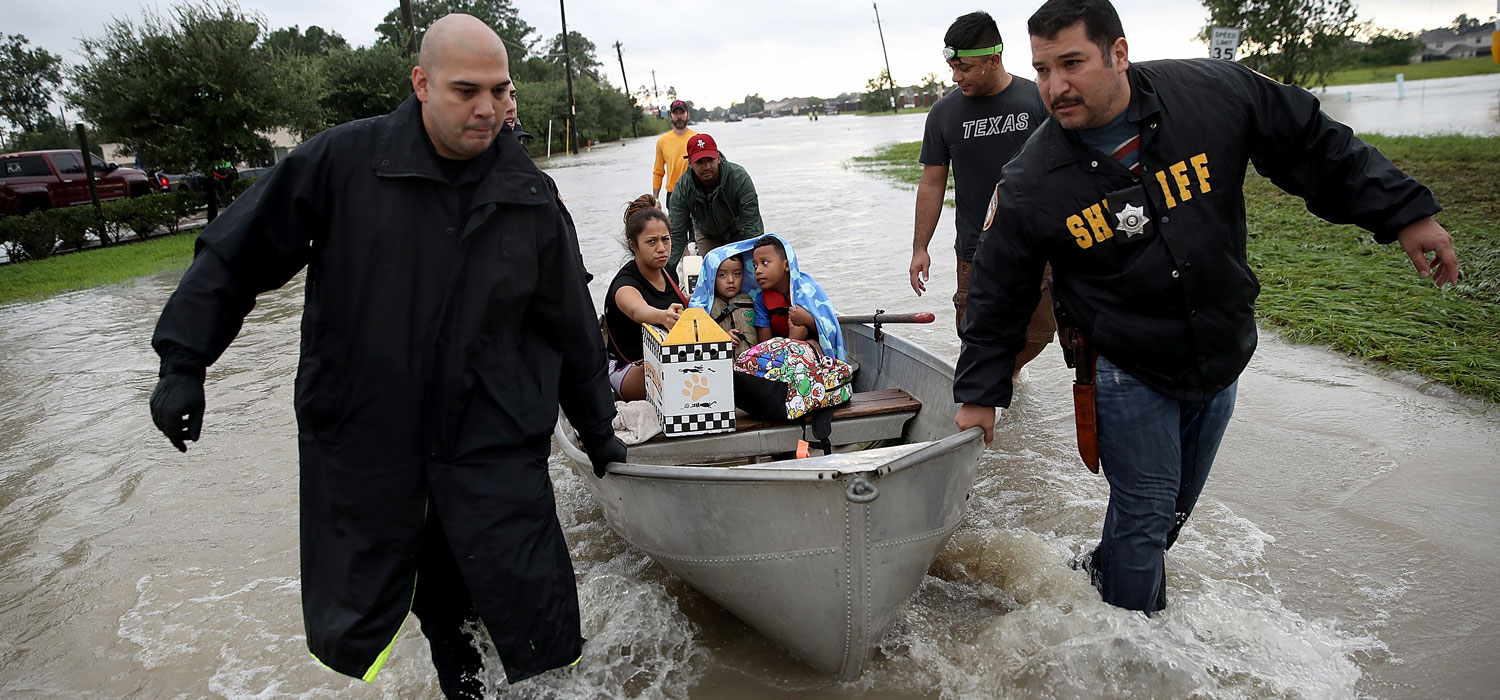
<p>The Tellez family is evacuated from their home after severe flooding following Hurricane Harvey in north Houston August 29, 2017 in Houston, Texas. Photo by Win McNamee/Getty Images.</p>
As a Houstonian, I’ve struggled to watch the floodwaters brought by Hurricane Harvey devastate my hometown over the past few days. But I’ve been encouraged by the resilience of Houstonians. Just as they demonstrated when the city opened its doors to Hurricane Katrina evacuees, Houstonians are generous, resourceful, and always willing to lend a helping hand.
As the residents of Houston rose to this occasion to help their neighbors, the city responded to the storm quickly and urgently, although rainwaters of this magnitude have never been seen before. And even though the disaster is still unfolding, Houston has already applied three important lessons from previous disasters.
1. Houston avoided a potentially disastrous evacuation.
Hurricane Rita in 2005 left 120 fatalities, but most of these were a result of the evacuation, which was the largest in US history. Thousands of people were stranded in miles-long traffic jams without access to gasoline, water, or shelter.
The impact of Rita prompted Mayor Turner to withhold issuing an evacuation order. Although this decision has been criticized, Mayor Turner acknowledged that more planning is needed to execute a successful evacuation of that magnitude, and his decision and advice to “shelter in place” prevented a potentially greater crisis.
2. Disaster mitigation paid off.
Hurricanes Katrina and Sandy showed us the importance of preparing for storms before they arrive. During Hurricane Katrina, the severe flooding that crippled New Orleans hospitals emphasized the need for planning by individual institutions.
After 2001’s Hurricane Allison cost the Texas Medical Center over $2 billion in research lost to flooding, the hospital installed a $50 million network of floodgates. The floodgates have kept Harvey’s immense rainwaters at bay, and the center is receiving patients from the surrounding areas.
3. Those who needed shelter found it.
More than 30,000 people have been placed in Houston’s temporary shelters, and the Federal Emergency Management Agency says it has provided more than a million meals and liters of water.
Although far from perfect, Houston’s shelters mark a vast improvement over the situation following Hurricane Katrina, when New Orleans’ Superdome’s roof was damaged by winds, and many shelters lacked the supplies needed to care for thousands of displaced residents.
As Houston recovers, long-term lessons become more important
The support of federal programs like Medicaid, Temporary Assistance for Needy Families, the Supplemental Nutrition Assistance Program, public housing, and unemployment compensation will be essential to Houston’s recovery. Policymakers should help ensure these programs can address complex logistical issues posed by cross-jurisdictional migration and diminished state fiscal capacity.
Houstonians will also continue to rely on the nonprofit sector to help rebuild, just as New Orleans did following Katrina. The entire country can help ensure that local and national organizations have the support they need to help Houston and surrounding areas.
New Orleans faced a long, complex recovery following Katrina that permanently changed the face of the city. As Houston recovers, it should focus on recovering and rebuilding with equity and inclusion, which my colleagues have thoroughly documented and studied. This focus can create more effective social supports for low-income and minority residents and protect these communities from being vulnerable to disasters in the future.
Our rapidly changing climate ensures that we will continue to grapple with major natural disasters. Researchers will continue to study the impact of this catastrophe to assess what went right, what went wrong, and what lessons should be remembered for the next challenge.
Houston will continue to rebuild over the coming days, weeks, and months. Based on what we’ve already seen from Houstonians, the recovery will be resilient.
Let’s build a future where everyone, everywhere has the opportunity and power to thrive
Urban is more determined than ever to partner with changemakers to unlock opportunities that give people across the country a fair shot at reaching their fullest potential. Invest in Urban to power this type of work.